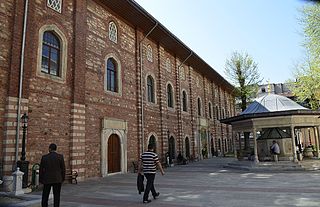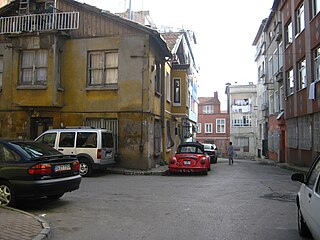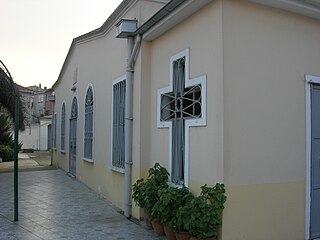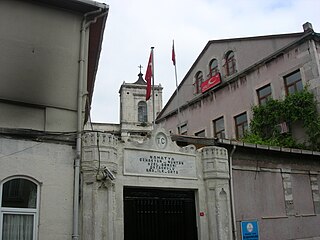Related Research Articles

Arap Mosque is a mosque in the Karaköy quarter of Istanbul, Turkey. The building was originally a Roman Catholic church erected in 1325 by the friars of the Dominican Order, near or above an earlier chapel dedicated to Saint Paul in 1233. Although the structure was altered during the Ottoman period, it is the only example of medieval religious Gothic Architecture remaining in Istanbul.

Samatya is a quarter of the Fatih district of Istanbul. It is located along the Marmara Sea, and borders to the west on the neighborhood of Yedikule.

Byzantine Iconoclasm refers to two periods in the history of the Byzantine Empire when the use of religious images or icons was opposed by religious and imperial authorities within the Orthodox Church and the temporal imperial hierarchy. The "First Iconoclasm", as it is sometimes called, existed between about 726 and 787. The "Second Iconoclasm" was between 814 and 842. According to the traditional view, Byzantine Iconoclasm was started by a ban on religious images by Emperor Leo III and continued under his successors. It was accompanied by widespread destruction of images and persecution of supporters of the veneration of images. The pope remained firmly in support of the use of images throughout the period, and the whole episode widened the growing divergence between the Byzantine and Carolingian traditions in what was still a unified church, as well as facilitating the reduction or removal of Byzantine political control over parts of Italy.

Fenâri Îsâ Mosque, in Byzantine times known as the Lips Monastery, is a mosque in Istanbul, made of two former Eastern Orthodox churches.

Gül Mosque is a former Eastern Orthodox church in Istanbul, Turkey, converted into a mosque by the Ottomans.

Church-Mosque of Vefa is a former Eastern Orthodox church converted into a mosque by the Ottomans in Istanbul. The church was possibly dedicated to Hagios Theodoros, but this dedication is far from certain. The complex represents one of the most important examples of Comnenian and Palaiologan architecture of Constantinople.

The Milion was a monument erected in the early 4th century AD in Constantinople. It was the Byzantine zero-mile marker, the starting-place for the measurement of distances for all the roads leading to the cities of the Byzantine Empire. It thus served the same function as the Golden Milestone in Rome's forum. The domed building of the Milion rested on four large arches, and it was expanded and decorated with several statues and paintings. It survived the Ottoman conquest of Constantinople in 1453 but had disappeared by the start of the 16th century. During excavations in the 1960s, some partial fragments of it were discovered under houses in the area.

Hirami Ahmet Pasha Mosque is a former Eastern Orthodox church converted into a mosque by the Ottomans. The small church, one among the 36 dedicated to Saint John the Baptist in Constantinople, was part of a monastery bearing the same name. Its full name was Saint John the Forerunner by-the-Dome. It is the smallest Byzantine church of Constantinople still extant and has never been studied.
Saint Theodosia of Constantinople is an Eastern Orthodox and Roman Catholic Saint and Martyr who lived in the seventh and eight centuries.

Koca Mustafa Pasha Mosque is a former Eastern Orthodox church converted into a mosque by the Ottomans, located in Istanbul, Turkey. The church, as the adjoining monastery, was dedicated to Saint Andrew of Crete, and was named Saint Andrew in Krisei or by-the-Judgment. Although heavily transformed during both the Byzantine and the Ottoman eras, it is one among the few churches in Istanbul still extant, whose foundation goes back to the sixth century.

Sancaktar Hayrettin Mosque is part of a former Eastern Orthodox monastery converted into a mosque by the Ottomans. It is generally believed that the small building belonged to the Byzantine Monastery of Gastria. The edifice is a minor example of Palaiologan architecture in Constantinople, and is important for historical reasons.

Saint Mary of Blachernae is an Eastern Orthodox church in Istanbul. The little edifice, built in 1867, got the same dedication as the shrine erected in this place in the fifth century which, until its destruction in 1434, was one of the most important sanctuaries of Greek Orthodoxy.

Saint George of Samatya or Surp Kevork is an Armenian church in Istanbul.

Toklu Dede Mosque, was an Ottoman mosque in Istanbul, Turkey. The building was originally a Byzantine Eastern Orthodox church of unknown dedication. It was almost completely destroyed in 1929.

Arslan Hane was a Byzantine Eastern Orthodox church converted into a profane building by the Ottomans in Istanbul, Turkey. The Church was dedicated to Christ of the Chalke, after the image of the Savior framed above the main entrance of the nearby Chalke Gate. This building, whose name stems possibly from its doors or tiles made with bronze, was the monumental vestibule of the Great Palace of Constantinople. The desecrated church, already heavily damaged by fire, was demolished in 1804.

The Forum of the Ox was a public square in the city of Constantinople. Used also a place for public executions and torture, it disappeared completely after the end of the Byzantine Empire.
Arcadia was the third daughter of Emperor Arcadius and Aelia Eudoxia and a member of the Theodosian dynasty.

The Neorion Harbour was a harbour in the city of Constantinople, active from the foundation of the city in the 4th century until the late Ottoman period. It was the first port to be built in Constantinople after its re-foundation by Constantine the Great, and the second in the area after the Prosphorion, which was the port of ancient Byzantium.

The Cistern of Aetius, known since the Ottoman period as Çukurbostan and since 1928 as Karagümrük stadyumu or Vefa stadyumu, was a Byzantine open-sky water reservoir in the city of Constantinople, important for historical reasons. Once one of the largest Byzantine cisterns, it is now a football stadium in Istanbul.

The Cistern of Mocius, known in Turkish as Altımermer Çukurbostanı, was the largest Byzantine open-sky water reservoir built in the city of Constantinople.